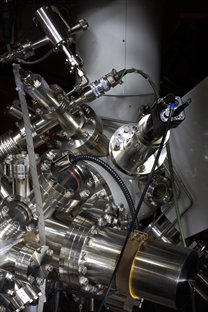X-ray photoelectron spectroscopy (XPS) is a very surface sensitive (top ~10nm) analysis technique that measures the elemental composition and chemical state of a material using the feedback from an induced photoelectron effect. It is sometimes known by the alternative name Electron Spectroscopy for Chemical Analysis (ESCA).

Images Courtesy of Vladimir Korolkov Photography
How does XPS work?
Samples are exposed to incident X-rays. Photons are absorbed by elements in the top few nanometres of the sample surface, leading to ionization and the emission of core (inner shell) electrons. The kinetic energy distribution of the emitted photoelectrons is measured in the spectrometer and the electron binding energies are determined.
For every element, there will be a characteristic binding energy associated with each core atomic orbital and therefore any given element produces a characteristic peak 'fingerprint' in the photoelectron spectrum.
Peak intensities can be related to the concentration of the given element allowing XPS to provide a quantitative analysis of surface composition.
Changes in oxidation state or chemical environment give rise to small variations in binding energy which in turn leads to small changes in peak position. These shifts are known as chemical shifts. The ability to discriminate between different oxidation states and chemical environments is a big advantage of the XPS technique.
XPS is not sensitive to hydrogen or helium, but can detect all other elements.
-
Spatially Resolved Molecular Compositions of Insoluble Multilayer Deposits Responsible for Increased Pollution from Internal Combustion Engines, Edney, M., Lamb, J., Spanu, M., Smith, E., Steer, E., Wilmot, E., Reid, J., Barker, J., Alexander, M., Snape, C. & Scurr, D., ACS Applied Materials & Interfaces, 12, 51026–51035 (2020).
-
Additive manufacture of complex 3D Au-containing nanocomposites by simultaneous two-photon polymerisation and photoreduction, Hu, Q., Sun, X.-Z., Parmenter, C. D. J., Fay, M. W., Smith, E. F., Rance, G. A., He, Y., Zhang, F., Liu, Y., Irvine, D., Tuck, C., Hague, R. & Wildman, R., Scientific Reports, 7, 17150 (2017).
-
Supramolecular networks stabilise and functionalise black phosphorus, Korolkov, V. v, Timokhin, I. G., Haubrichs, R., Smith, E. F., Yang, L., Yang, S., Champness, N. R., Schröder, M. & Beton, P. H., Nature Communications, 8, 1385 (2017).
-
Resolving X-ray photoelectron spectra of ionic liquids with difference spectroscopy, J., Maxwell-Hogg, S., Smith, E. F., Hawker, R. R., Harper, J. B. & Licence, P., Physical Chemistry Chemical Physics, 21, 114–123 (2019).
-
An antimicrobial impregnated urinary catheter that reduces mineral encrustation and prevents colonisation by multi-drug resistant organisms for up to 12 weeks, Belfield, K., Chen, X., Smith, E. F., Ashraf, W. & Bayston, R., Acta Biomaterialia, 90, 157–168 (2019).
-
Reverse Semi-Combustion Driven by Titanium Dioxide-Ionic Liquid Hybrid Photocatalyst, Qadir, M. I., Zanatta, M., Pinto, J., Vicente, I., Gual, A., Smith, E. F., Neto, B. A. D., de Souza, P. E. N., Khan, S., Dupont, J. & Alves Fernandes, J., ChemSusChem, 13, 5580–5585 (2020).
-
Nanobugs as Drugs: Bacterial Derived Nanomagnets Enhance Tumor Targeting and Oncolytic Activity of HSV-1 Virus, Howard, F. N., Al-Janabi, H., Patel, P., Cox, K., Smith, E., Vadakekolathu, J., Pockley, A. G., Conner, J., Nohl, J. F., Allwood, D. A., Collado-Rojas, C., Kennerley, A., Staniland, S. & Muthana, M., Small, 18, 2104763 (2022).